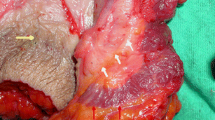Abstract
PURPOSE: This study was designed to evaluate the anatomic and functional consequences of lateral internal sphincterotomy in patients who developed anal incontinence and in matched controls. METHODS: The study includes 13 patients with anal incontinence after lateral internal sphincterotomy and 13 controls who underwent the same operation and were continent and satisfied with the results of the procedure. Patients underwent clinical evaluation, anorectal manometry, pudendal nerve terminal motor latency testing, and endoanal ultrasonography. RESULTS: Sphincterotomies were longer in incontinent patients (75vs. 57 percent), but the resting pressure and length of the high-pressure zone were not different between groups. Surprisingly, maximum voluntary contraction was higher in incontinent patients than in continent controls (136vs. 100 mmHg). Rectal sensation and pudendal nerve terminal motor latency were similar in both groups. The defect in the internal sphincter was wider in incontinent patients than in continent controls (17.3vs. 14.4 mm), but these differences were not statistically significant. The thickness of the internal sphincter measured by endoanal ultrasound was identical in both groups, but the external sphincter was thinner in incontinent patients both at the site of the sphincterotomy (6.8vs. 8.1 mm) and in the posterior midline (7.1vs. 8.6 mm). CONCLUSIONS: Anal incontinence after lateral internal sphincterotomy is directly related to the length of the sphincterotomy. Whether secondary to preoperative sphincter abnormality or the result of lateral internal sphincterotomy, the external sphincter is thinner in incontinent patients than in continent controls.
Similar content being viewed by others
References
Farouk R, Duthie GS, MacGregor AB, Bartolo DC. Sustained internal sphincter hypertonia in patients with chronic anal fissure. Dis Colon Rectum 1994;37:424–9.
Chowcat NL, Araujo JG, Boulos PB. Internal sphincterotomy for chronic anal fissure: long term effects on anal pressure. Br J Surg 1986;73:915–6.
Khubchandani IT, Reed JF. Sequelae of internal sphincterotomy for chronic fissure in ano. Br J Surg 1989;76:431–4.
García-Aguilar J, Belmonte C, Wong WD, Lowry AC, Madoff RD. Open vs. closed sphincterotomy for chronic anal fissure: long-term results. Dis Colon Rectum 1996;39:440–3.
Rothenberger DA. Anal incontinence. In: Cameron JL, ed. Current surgical therapy. 3rd ed. Philadelphia: BC Decker, 1989:186–94.
McNamara MJ, Percy JP, Fielding IR. A manometric study of anal fissure treated by subcutaneous lateral internal sphincterotomy. Ann Surg 1990;212:235–8.
Melange M, Colin JF, Van Wymersch T, Vanheuverzwyn R. Anal fissure: correlation between symptoms and manometry before and after surgery. Int J Colorectal Dis 1992;7:108–11.
Sultan AH, Kamm MA, Nicholls RJ, Bartram CI. Prospective study of the extent of internal anal sphincter division during lateral sphincterotomy. Dis Colon Rectum 1994;37:1031–3.
Champigneule B, Dieterling P, Bigard MA, Gaucher P. Etude prospective de la fonction sphinctérienne anale avant et aprés hemorrhoidectomie. Gastroentrol Clin Biol 1989;13:452–6.
Felt-Bersma RJ, van Baren R, Koorevaar M, Strijers RL, Cuesta MA. Unsuspected sphincter defects shown by anal endosonography after anorectal surgery: a prospective study. Dis Colon Rectum 1995;38:249–53.
Nielsen MB, Hauge C, Rasmussen OØ,et al. Anal sphincter size measured by endosonography in healthy volunteers. Effect of age, sex and parity. Acta Radiol 1992;33:453–6.
Sultan AH, Kamm MA, Hudson CN, Thomas JM, Bartram CI. Anal-sphincter disruption during vaginal delivery. N Engl J Med 1993;329:1905–11.
Reissman P. Significance of anal canal ultrasound before sphincterotomy in multiparous women with anal fissure [letter]. Dis Colon Rectum 1996;39:1060.
Sultan AH, Kamm MA, Hudson CN, Nicholls JR, Bartram CI. Endosonography of the anal sphincters: normal anatomy and comparison with manometry. Clin Radiol 1994;49:368–74.
Madoff RD, Williams JG, Caushaj PH. Fecal incontinence. N Engl J Med 1992;326:1002–7.
Author information
Authors and Affiliations
Additional information
Read at the meeting of The American Society of Colon and Rectal Surgeons, Montreal, Quebec, Canada, May 7 to 12, 1995.
About this article
Cite this article
García-Aguilar, J., Belmonte Montes, C., Javier Perez, J. et al. Incontinence after lateral internal sphincterotomy. Dis Colon Rectum 41, 423–427 (1998). https://doi.org/10.1007/BF02235754
Issue Date:
DOI: https://doi.org/10.1007/BF02235754




